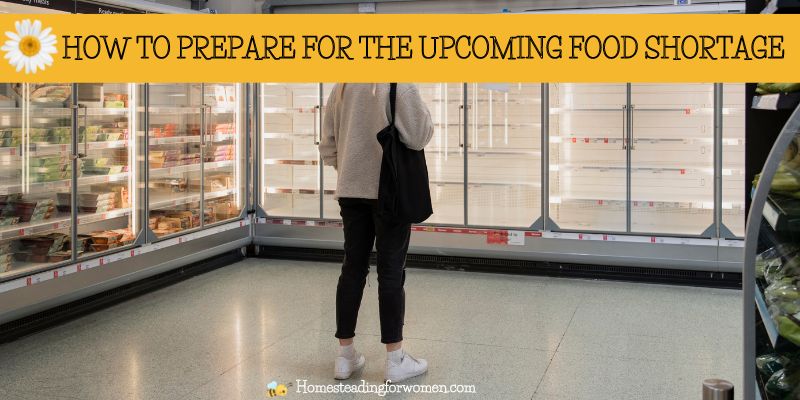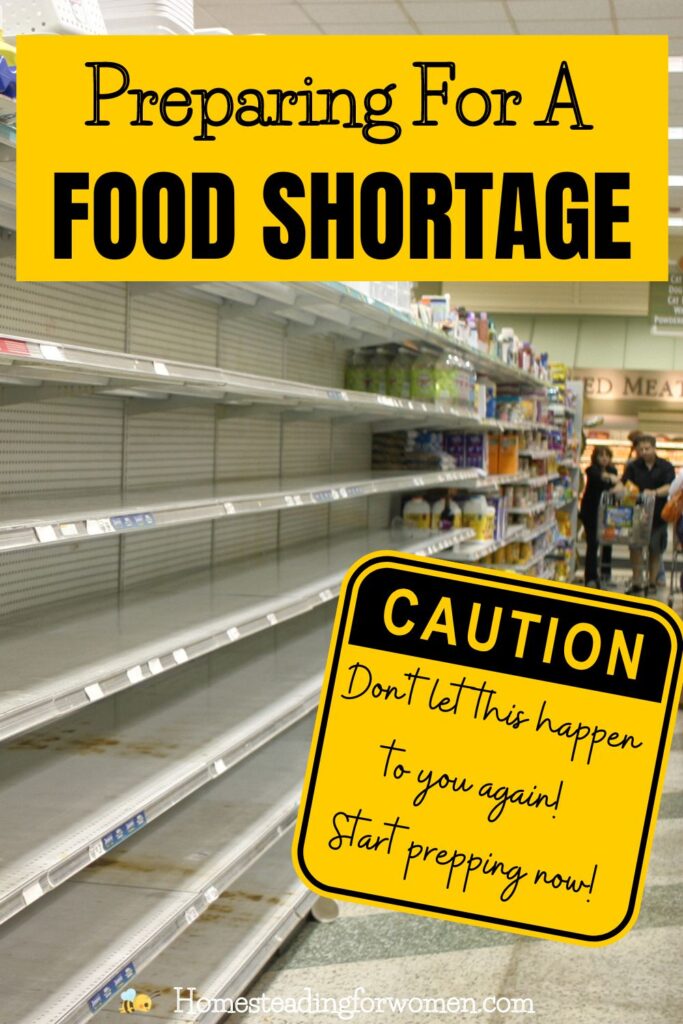Welcome to Homesteading For Women – we hope you enjoy all our tips and tricks for homestead women! Please note that we use affiliate links and ads to generate income at no cost to you.
Food shortages is a topic that has become more prevalent in today’s society for many different reasons. At the start of the pandemic, many consumers became aware of just how fragile the supply chain is when they arrived at the store and saw empty shelves that would not be refilled within days. Today I’ll share how to prepare for the upcoming food shortage so you won’t get caught unprepared.
We all are aware that if the weather man calls for heavy snow then you can count on there not being any milk or bread in the store because everyone is stocking up for a few days in case they can’t get to the store for a few days.
And while the store may run out of stock of those things, consumers have always been able to rely on the fact that store shelves would be restocked on the next delivery date, within the week.

PREPARING FOR A FOOD SHORTAGE
However, the pandemic was an eye-opening event that showed the truth about our reliance on a supply chain that is not unbreakable. To this day, there are places where parents are unable to find baby formula, other goods such as pasta are scarce, and even restaurants are putting up signs that they are low on common foods such as chicken.
Even at the current level of food shortages, there are many who take for granted the supply chain and assume that they will always have enough to feed their family, even if it’s not their favorite foods.
However, you never know when the next step will be taken where suddenly there are no grains to be found to make many of your favorite foods. This is already a situation where the Russia-Ukraine war is threatening our supply, as is the drought in Canada and elsewhere.
You need to be fully prepared for food shortage situations. This is something that can happen overnight or within days. You don’t want to have to scramble along with everyone else at the last minute.
IS THERE A FOOD SHORTAGE COMING?
I believe there is, I’ve seen the signs in many places this year, from massive amounts of beef cattle plants and chicken farms burning to some crop failures just to name a few, things are not looking good. So I decided to put together this post to share with you how to prepare for a food shortage.
Living out in a rural area I have to plan ahead for certain emergencies, such as the power going off during bad weather. In some cases, we have been without power for a week. This can be tough when it’s winter and you have to keep warm as well as finding a way to keep your food from spoiling. I’m here to help you learn how you can stock up your pantry for the coming food shortage so you won’t be caught unprepared.

HOW TO PREPARE FOR FOOD SHORTAGE
The first thing you should do is take inventory of what you have already on hand in your pantry. I created this awesome Emergency Food Planner just for that task of making a list of every food item I had in the kitchen. I wanted to get a list of all the can goods I had, everything in the freezer, and a list of the staples. This planner helped me so much and it can help you take the first step in preparing for the upcoming food shortage, just by writing down everything you have already on hand you will have a good starting point for stocking up food for your family.
NEXT STEP> FIGURE OUT HOW MUCH FOOD YOU NEED
That’s pretty easy it depends on who is living with you right now or in the future. Do you have enough food to last a month? What we like to do is go to the grocery store only once a month. This not only saves us a lot of money, by it keeps us stocked up all the time. We stick within our budget and only use one cart, there’s just three of us and when the cart is full, we’re done.
This has helped me realize what we are actually consuming each month. For example, if I run out of green tea in that month. Next month I put on the shopping list that I need two containers of tea. Start by writing down what your family is eating each month and use that as your grocery list for the next month.
WHAT TO STOCK UP ON FOR FOOD SHORTAGE
When you’re in a situation where food is scarce, you have to focus on three things. He first is making sure everyone gets enough calories to sustain them throughout the day. This will vary from person to person.
The second is making sure your food is shelf stable for as long as possible. While some foods may expire in a week (like fresh produce), other food can last 10-30 years when stored properly.
The third, which we’ll talk about shortly, is making sure that the foods you eat are rich in nutrients, not just calories. You need to make sure you’re eating food that will give you plenty of vitamins and minerals to keep you healthy.
When you start stocking up on survival food, you need to focus on the calories and shelf stability first. Calculate how many calories your family needs. It will vary a lot between a grown man and a little girl, so make sure you’re running the numbers accurately.
Things like canned meat, nuts, and other items can pack a punch in terms of calories and give you the kind of long-term food storage that you need. Grains also deliver a lot of calories, as do pasta dishes.
You want to make sure your pantry is stocked with beans and dehydrated potatoes, too. It’s not just about the foods themselves, but the pantry staples that will add flavor and calories, too.
This includes things like sugar, flour, honey, oil, and more. Whenever you shop for survival foods, compare the calories and nutrients. For example, peas will provide you with more calories than other vegetables.
You may want to stock up on survival ration bars for survival, too. These are not the most delicious meals to eat, but they will deliver the calories you need at about 410 calories per bar.
These kinds of bars are not meant to be the ultimate in health food, but instead, to provide the calories you need to sustain your energy levels. They often have sugar and other ingredients to get you through a survival situation, not necessarily provide optimal health.
GROW YOUR OWN FOOD SELF-SUFFICIENCY
When it comes to surviving a food shortage situation, you won’t always be able to just go to the store and stock up on what you need. Sometimes, you’ll have to grow your own food self-sufficiency.
This is a wonderful homesteading skill to have early on before you actually need it. Whether you’re growing in the ground or planting crops in containers, you want to be growing crops that not only provide calories, but also the nutrients you need to stay healthy.
For calories, think about crops that have a high yield. Tomatoes, beans, corn, potatoes, and other items can give you a lot of food to feed your family. If you can grow avocados, that’s a great option, too.
For those who have room on their property, nut trees would be a fantastic crop to plant. These take a long time to mature, but worth it! You can get plenty of calories from walnuts, pecans, and other items if you’re lucky enough to have them growing on your property.
In terms of nutrients, look to grow a variety of different, and your skill level of gardening. For example, tomatoes are easy to grow in the ground or in a container, and they yield a big crop, enough for your family and friends. Carrots are another great crop for containers and are easy to grow.
Leafy greens like collards can deliver a lot of vitamins that you’ll need to maintain good health. You want foods that will provide vitamins naturally. You may not be able to order supplements to get things like vitamin C.
Make sure that when you plan what to plant in your garden, you’re taking time to consider what your family likes to eat. While it may not matter in a true SHTF situation where people are starving, it’s always smart to grow what your family enjoys eating.
You also have to consider what foods still store well, and for the longest time. You can certainly freeze some of your produce if the grid is up. You can also freeze dry or dehydrate your food, can and ferment it whenever applicable.
HUNTING GAME FOR MEAT
You might think that you’ll just hunt all your meat for the family. That was the thing to do back in the day. But times have changed. And everyone and his brother will be thinking the same thing. There will be no time to go out hunting if things get really bad and not enough land for everyone to hunt. Besides where I live, when hunting season starts our deer leave the area for more unpopulated areas until everyone leaves then they come back to eat grass in our fields. Lol!
Eggs are perhaps the easiest protein to prepare for. You can raise hens that lay eggs for you on a regular basis. Not only can you eat the eggs directly, but you can cook with them to make things like pasta and cakes or other items where the recipe calls for an egg.
Chicken is also good for the meat, too. You can raise chickens to butcher for cooking over a fire, boiling, baking, and more. You’ll need to make sure you raise healthy chickens that aren’t susceptible to disease and that you protect them with a sturdy chicken coop to keep them safe from predators.
Rabbits can also be raised for their meat. You can build or buy a rabbit hutch and keep rabbits that will reproduce and provide more meat and protein for your family over a period of time.
Goats can not only provide milk but meat, too. You can sometimes use the hide of the goat for other purposes, as well. Goats don’t take up a lot of room on your property, and they also keep the grass cut naturally for you. You’ll need a good fence for these, but they are great at clearing out briars on a homestead property.
Pigs don’t require a lot of care. They eat just about anything and provide ample amounts of meat when butchered. You can cure the meat that you don’t cook right away and turn it into a jerky for longevity. These are pretty stinky, be sure to put the pen far from the house.
Sheep can provide plenty of wool as well as milk and meat when you raise them for survival purposes. There are different types of sheep, so you’d need whatever was best suited to your intentions. I would LOVE to have my own sheep for its wool to spin into yarn, but haven’t talked Mr. B into that yet. Lol!
Cows, if you have enough property to raise them, are a fantastic protein source. They can provide milk for you and your family. They also deliver huge quantities of meat you can freeze or dry for later use.
They do require quite a bit of land, so this is not something you’d want to buy for survival purposes if you only had a small backyard.
MAKE SURE YOU HAVE A WAY TO COOK AND STORE FOOD IF THE ELECTRICITY GOES OUT
Part of making sure you can provide food for your family means you have a way to cook and store everything safely. Whether you’re growing your own food in your garden or with animals, you need to make sure you’re not wasting food, or you’re opening a shelf-stable bucket of survival food, you need to know how to keep it from being ruined.
Always have a cool, dry space to store your survival foods. If you try to store it in a hot garage, chances are it’s going to spoil before you can use the food that you so carefully purchased.
Start by investing in a freezer where you can safely store large supplies of meat. Many people will buy half a cow and have it processed to store in their freezer to use up over the course of a year.
If the grid is down, that won’t help much. You need a way to dehydrate your food so that all it requires is the addition of water (or to eat as is). For example, you can dehydrate meat and use a variety of jerky recipes.
Knowing how to can food, such as the fruits and vegetables you’ve grown in your garden, will come in handy. This can provide you with shelf-stable side dishes for years.
For cooking, you need to have both indoor and outdoor options. A simple camping stove can allow you to cook or warm up some food indoors in a pinch. But you also want to have things like cast iron pots and pans, a coffee pot, and a fire pit to cook outdoors.
I hope this post will help you prepare for a food shortage or at least learn to stock up like a true homesteader.

- Caring for Aging Parents: What I’ve Learned the Hard Way (And Why I’m Planning Ahead Now) - August 4, 2025
- 7 Must Get Beginner Herbal Books For Your Library - July 30, 2025
- What to Have Ready When the Power Goes Out (Even at 6AM!) - July 27, 2025
